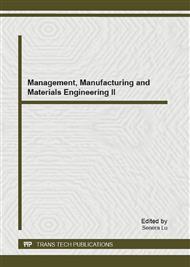p.105
p.110
p.115
p.123
p.128
p.134
p.139
p.144
p.149
Evaluation of Tobacco Mixing Uniformity Based on Projection Pursuit
Abstract:
A new comprehensive evaluation method of tobacco mixing uniformity was presented in this paper. In this method, projection pursuit model was used to select evaluation index and determine the index weights. Seven chemical compositions which had a major impact on the overall evaluation, such as total volatile acid, total volatile bases, PH, polyphenol, protein, total nitrogen and chlorine were sampled repetitiously and calculated the average and coefficient of variance. Tobacco mixing uniformity was evaluated by the score according to coefficient of variance. Comprehensive evaluation of five batches of tobacco was carried out and the results were consistent with the traditional. This method was easy to get basic data and evaluation results fitted the actual. It was a simple and practical evaluation method of mixing uniformity.
Info:
Periodical:
Pages:
128-133
Citation:
Online since:
December 2012
Authors:
Price:
Сopyright:
© 2013 Trans Tech Publications Ltd. All Rights Reserved
Share:
Citation:


